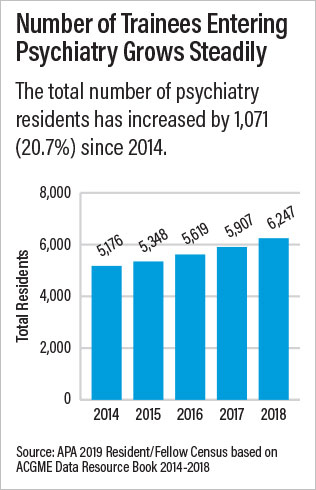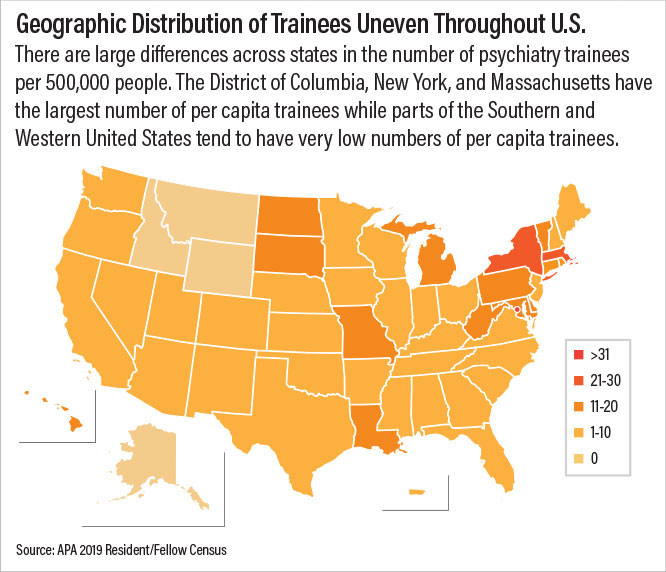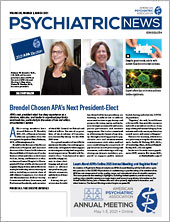APA’s 2019 Resident/Fellow Census provides a revealing demographic portrait of the resident and fellow population. The census is a data-driven profile of psychiatry trainees in the academic year 2017-2018, with data going back to 2013-2014 for comparative purposes.
One clear takeaway is that the trainee population is growing: The number of psychiatry residents has increased by 1,071 (20.7%) since 2014 (see chart). The percentage of psychiatry training positions offered in the National Resident Matching Program (NRMP) that are filled rose to 99% in 2016 and has continued at about that level for the last three years.
Here are some other key findings in the census:
•
Of a total of 6,247 residents in 2018, 48.7% were women. Among fellows, there continue to be substantial gender differences in some subspecialties: men comprised 63.9% of addiction fellows in 2018, while women comprised 59.7% of child and adolescent fellows, 57.7% of geriatric fellows, and 63.6% of forensic fellows.
•
52% of PGY-1 residents are White, 24% are Asian, 8.49% are Hispanic, and 6% are Black.
•
Child and adolescent psychiatry continues to have the largest number of trainees—869 in 2018.
•
Since 2014, the percentage of trainees in addiction psychiatry has increased 26%, while the percentage of trainees in geriatric psychiatry has decreased by 10%. The number of trainees in consultation-liaison psychiatry had been increasing but decreased by 17% from 2017 to 2018.
•
There are large differences across states in the number of psychiatry trainees per capita. The District of Columbia, New York, and Massachusetts have the largest number of per capita trainees, while parts of the Southern and Western United States tend to have very low numbers of per capita trainees (see map).
“The yearly census provides a useful snapshot of the resident/fellow population at a point in time,” said Tristan Gorrindo, M.D., APA chief of education. “It supplies important workforce information for planning, recruitment, and retention efforts of training programs.”
He noted that the portrait of the current resident/trainee population is affected by wider trends in medicine and society and should not be extrapolated to draw conclusions about long-term trends in psychiatry. “We will need to study in further detail the drivers of demographic change.”
Data for the census are gathered from the Accreditation Council for Graduate Medical Education Data Book and the National Resident Matching Program Data Resource. Additional data are derived from the GME Track Survey, an online survey jointly sponsored by the Association of American Medical Colleges and the AMA.
The report was made possible through the efforts of the APA Membership and Member Engagement Office and the APA Division of Education in collaboration with co-authors Sanya Virani, M.D., M.P.H., a fellow in addiction psychiatry at the Yale School of Medicine and APA’s resident-fellow member trustee-elect for APA; and Tanner Bommersbach, M.D., M.P.H., a PGY-3 resident at Yale University and an APA/APAF Public Psychiatry Fellow.
Co-authors also included Gorrindo and Lisa Diener, director of the Department of Membership and Member Engagement. ■
APA’s 2019 Resident/Fellow census is posted
here.


